
Huabeisaurus was a genus of dinosaur from the Late Cretaceous. It was a sauropod which lived in what is present-day northern China. The type species, Huabeisaurus allocotus, was first described by Pang Qiqing and Cheng Zhengwu in 2000. Huabeisaurus is known from numerous remains found in the 1990s, which include teeth, partial limbs and vertebrae. Due to its relative completeness, Huabeisaurus represents a significant taxon for understanding sauropod evolution in Asia. Huabeisaurus comes from Kangdailiang and Houyu, Zhaojiagou Town, Tianzhen County, Shanxi province, China. The holotype was found in the unnamed upper member of the Huiquanpu Formation, which is Late Cretaceous (?Cenomanian–?Campanian) in age based on ostracods, charophytes, and fission-track dating.
This glossary of ichthyology is a list of definitions of terms and concepts used in ichthyology, the study of fishes.

Anatosuchus is an extinct genus of notosuchian crocodylomorph discovered in Gadoufaoua, Niger, and described by a team of palaeontologists led by the American Paul Sereno in 2003, in the Journal of Vertebrate Paleontology. Its duck-like snout coincidentally makes it resemble a crocoduck, an imagined hybrid animal with the head of a crocodile and the body of a duck.

Fiona pinnata, common name Fiona, is a species of small pelagic nudibranch, a marine gastropod mollusk in the superfamily Fionoidea. This nudibranch species lives worldwide on floating objects on seas, and feeds mainly on barnacles, specifically goose barnacles in the genus Lepas.
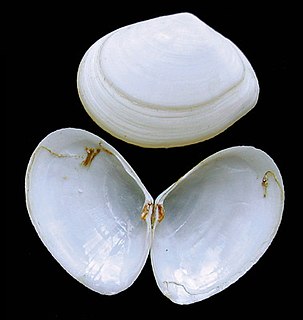
A bivalve shell is part of the body, the exoskeleton or shell, of a bivalve mollusk. In life, the shell of this class of mollusks is composed of two hinged parts or valves. Bivalves are very common in essentially all aquatic locales, including saltwater, brackish water, and freshwater. The shells of bivalves commonly wash up on beaches and along the edges of lakes, rivers, and streams. Bivalves by definition possess two shells or valves, a "right valve" and a "left valve", that are joined by a ligament. The two valves usually articulate with one another using structures known as "teeth" which are situated along the hinge line. In many bivalve shells, the two valves are symmetrical along the hinge line—when truly symmetrical, such an animal is said to be equivalved; if the valves vary from each other in size or shape, inequivalved. If symmetrical front-to-back, the valves are said to be equilateral, and are otherwise considered inequilateral.
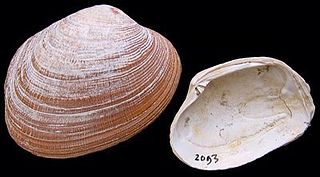
The grooved carpet shell, or Palourde clam, Ruditapes decussatus, or Venerupis decussatus, is a clam in the family Veneridae. It is distributed worldwide and due to its ecological and economic interest has been proposed as a bioindicator.
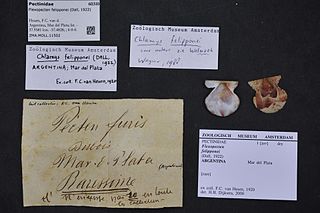
Flexopecten felipponei is a species of saltwater scallop, a marine bivalve mollusk in the family Pectinidae, the scallops.

Cucumerunio websteri is a species of freshwater mussel, an aquatic bivalve mollusc in the family Hyriidae.
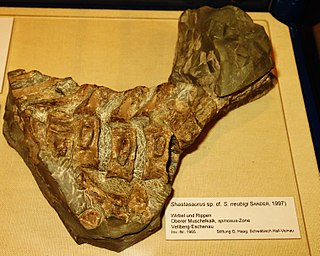
Phantomosaurus is an extinct genus of ichthyosaur that lived during the late Anisian stage of the Middle Triassic. It would have been around 6 metres long, with a skull of 50 cm.

Polonosuchus is a genus of rauisuchid known from the late Triassic of Poland. It was a huge predator about 5–6 metres in length and, like all rauisuchians, was equipped with a large head of long sharp teeth. The legs were placed almost underneath the body, unlike most reptiles, which would have made it quite fast and a powerful runner. The appearance was very similar to that of the more known Postosuchus, of North America, and shared with the latter the ecological niche of the apex predator.

Kaprosuchus is an extinct genus of mahajangasuchid crocodyliform. It is known from a single nearly complete skull collected from the Upper Cretaceous Echkar Formation of Niger. The name means "boar crocodile" from the Greek κάπρος, kapros ("boar") and σοῦχος, soukhos ("crocodile") in reference to its unusually large caniniform teeth which resemble those of a boar. It has been nicknamed "BoarCroc" by Paul Sereno and Hans Larsson, who first described the genus in a monograph published in ZooKeys in 2009 along with other Saharan crocodyliformes such as Anatosuchus and Laganosuchus. The type species is K. saharicus.
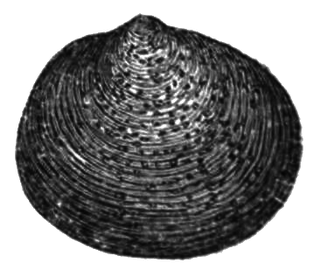
Pisidium punctiferum, the striate peaclam, is a freshwater bivalve of the family Sphaeriidae.
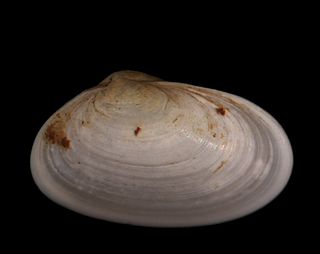
Tellimya ferruginosa is a species of small marine bivalve mollusc in the family Lasaeidae. It is found on the eastern side of the Atlantic Ocean.
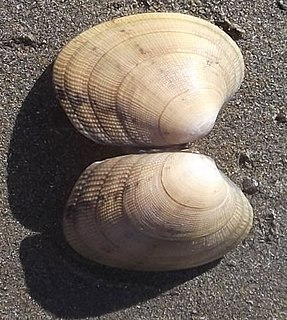
Venerupis decussata is a marine bivalve mollusc in the family Veneridae, commonly known as the cross-cut carpet shell.

Sharpirhynchia sharpi is a species of extinct, small-sized lampshell, named after Samuel Sharp (1814–1882), an early fossil collector, who discovered the limited time span of some fossils, now known as index fossils. S. sharpi is a marine rhynchonellate brachiopod in the family Rhynchonellidae. It is roughly ½ inch (1.25 cm) measured along the axis, with a slender beak, the brachial valve more convex than the pedunculate valve, and it has 21–31 ribs fanning out from the hinge.

Rhynchonelloidella alemanica is a species of extinct, small-sized brachiopod, a marine rhynchonellate lampshell in the family Rhynchonellidae. It is roughly 1.4 cm (0.55 in), and has about 15 ribs fanning out from the hinge.

Hinge teeth are part of the anatomical structure of the inner surface of a bivalve shell, i.e. the shell of a bivalve mollusk. Bivalves by definition have two valves, which are joined together by a strong and flexible ligament situated on the hinge line at the dorsal edge of the shell. In life, the shell needs to be able to open slightly to allow the foot and siphons to protrude, and then close again, without the valves moving out of alignment with one another. To make this possible, in most cases the two valves are articulated using an arrangement of structures known as hinge teeth. Like the ligament, the hinge teeth are also situated along the hinge line of the shell, in most cases.

Pyganodon grandis, the giant floater, is a species of freshwater mussel, an aquatic bivalve mollusk in the family Unionidae, the river mussels. This species is fast-growing, large, and has a short lifespan.

Sahitisuchus is an extinct genus of sebecid mesoeucrocodylian known from Rio de Janeiro State of southeastern Brazil. It contains a single species, Sahitisuchus fluminensis. It is a terrestrial sebecid, however also adopted to a semi-aquatic lifestyle to some degree, most probably coexisting with the semi-aquatic alligatorid Eocaiman itaboraiensis.

Fusconaia burkei is a species of freshwater mussel, an aquatic bivalve mollusk in the family Unionidae, the river mussels.




















